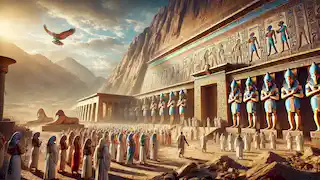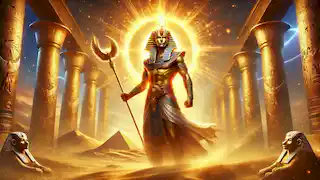In the scorching sands of ancient Egypt, where the sun cast a relentless golden glow upon the land, there existed a tale that would be retold for generations. It was the story of Ra, the Sun God, and the trials he faced to protect the balance of the cosmos and secure his reign over the earth and sky. This story, like the shifting dunes of the desert, evolved over time, a legendary saga reflecting the undying reverence the people of Egypt held for the god of the sun.
Ra was not only a symbol of power but also the embodiment of life itself. He rode his solar barque through the sky each day, fighting against the chaos that threatened to engulf the world. His journey from the sunrise to the sunset symbolized the cycle of life and death, order and chaos, and the eternal struggle to maintain balance. But even a god like Ra was not immune to the challenges and perils that lay hidden in the shadows of his own kingdom. Long ago, when the world was young, there was only darkness and silence. The primordial waters of Nun covered everything, a vast, chaotic sea that stretched endlessly into nothingness. Within this endless sea lay Atum, the self-created god, who would bring forth life and order to the void. Atum felt a stirring within his own essence, a desire to give shape to the world. From the depths of his being, he summoned Ra, the Sun God, a blazing force of light and warmth. Ra burst forth from Atum, his radiant presence piercing the darkness and illuminating the universe. His emergence marked the dawn of creation, the first light that would forever transform the realm of chaos into a world filled with life and purpose. Ra looked upon the waters of Nun and spoke his first command: “Let there be order in this chaos.” His voice echoed through the void, and the waters began to part, giving birth to land. Ra’s light touched the land, making it fertile and abundant. It was here that he crafted the first beings, creating gods and goddesses to serve as stewards of his new realm. Among them were Shu, the god of air, and Tefnut, the goddess of moisture, who would help Ra shape the world according to his vision. As Ra’s creation took form, he was hailed as the supreme god, the ruler of the heavens and the earth. Every dawn, Ra would ride his solar barque across the sky, showering the land with his divine light. But as with all things, Ra’s supremacy would soon be tested. In the shadowy depths of the Duat, the Egyptian underworld, a powerful serpent named Apep lay coiled in wait. Apep, also known as the Serpent of Chaos, despised Ra and all that he represented. While Ra’s light brought life and order, Apep thrived on darkness and disorder. Driven by an insatiable desire to engulf the world in chaos, Apep vowed to destroy Ra and plunge Egypt into eternal night. Each night, as Ra descended into the Duat, he would face Apep in a battle that was fierce and relentless. Apep, with scales as dark as the deepest night, would rise from the shadows and attempt to devour Ra’s light. The clash between the two forces was one of cosmic significance—a battle that decided the fate of the world each night. Ra, however, was prepared. He had allies: Set, the god of storms and deserts, who fought by his side, wielding his spear to strike Apep and hold the serpent at bay. Despite the odds, Ra and his followers were able to overcome Apep’s attacks each night, allowing the sun to rise again each morning. This nightly victory was celebrated by the people of Egypt, who saw it as a triumph of order over chaos, of life over death. Yet, Ra knew that Apep would never cease in his efforts to bring about darkness, and so he remained vigilant, prepared for the serpent’s return each night. As centuries passed, Ra grew weary. Though his power was unrivaled, the burden of eternal guardianship weighed heavily upon him. He looked down upon the people of Egypt, who had come to rely on his light and protection, and felt a longing for a life free of duty. Ra knew that without his presence, chaos would soon consume the world, but even a god could not ignore his own desires indefinitely. One day, the goddess Hathor approached him. She was the goddess of joy, music, and dance, a radiant presence who brought delight to all who encountered her. Seeing Ra’s fatigue, Hathor sought to ease his burden. She whispered sweetly of a paradise beyond the reach of Apep, a place where gods could rest and be free from earthly responsibilities. Tempted by her words, Ra considered abandoning his daily journey across the sky. He imagined a world without him, where he could finally experience the freedom he had longed for. But as he pondered this possibility, the other gods grew uneasy. They knew that without Ra’s light, the world would descend into chaos, and so they devised a plan to remind him of his duty. They invited Ra to a great feast, filling the hall with the laughter and joy of the gods. As Ra watched his fellow deities revel in their freedom, he was reminded of the purpose he served. He was not just a god but the guardian of life itself. Refreshed by the revelry and the realization of his importance, Ra resolved to continue his journey, to protect the world that had become his creation and his responsibility. Ra’s decision to stay brought joy to the other gods, and they sought to honor him by creating beings who would worship and serve him faithfully. Together, they fashioned humans from the clay of the Nile, breathing life into them and granting them the gift of reason and language. These new creatures, fragile yet resilient, were entrusted with the duty of honoring Ra and upholding his order upon the earth. The humans worshiped Ra with fervor, building grand temples and offering prayers that echoed across the land. Ra was pleased with their devotion, for he saw in them a reflection of his own divine essence. The humans, in their simplicity and earnestness, reminded Ra of the beauty and fragility of life. Yet, as humans multiplied and spread across the land, they began to grow arrogant and forgetful of their creator. Some even questioned Ra’s power, challenging the gods and bringing disorder to the world. Displeased, Ra decided that they must be reminded of their place in the grand design. He summoned Sekhmet, the lion-headed goddess of war, and unleashed her upon the earth to punish the rebellious humans. Sekhmet’s fury was unparalleled; she brought destruction and despair upon those who had dared to defy the gods. Yet, as the bloodshed grew, Ra’s heart softened. He saw the suffering of his creations and felt pity for them, for they were, after all, his children. To stop Sekhmet’s rampage, Ra devised a clever plan. He poured red wine across the land, tricking Sekhmet into drinking it, believing it to be the blood of her victims. Drunk and pacified, Sekhmet ceased her assault, and peace returned to the land. This event served as a reminder to humans of the power and mercy of their creator, and they redoubled their efforts to honor Ra and uphold his teachings. As the years turned into centuries, Ra grew older. Though he remained powerful, he knew that even gods were not immune to the passage of time. He began to prepare for the day when he would descend into the Duat for the final time, to join the gods who had come before him. One evening, as the sun dipped below the horizon, Ra felt a strange pull, as if the Duat itself were calling to him. He gathered his closest allies—Horus, the falcon-headed god; Thoth, the god of wisdom; and Anubis, the jackal-headed guide of the dead—and prepared to journey into the underworld. As they traveled through the dark, twisting passages of the Duat, Ra encountered the spirits of the dead, who reached out to him with pleas and praises. His light illuminated the path, dispelling the darkness and guiding lost souls toward their final rest. Yet, as they ventured deeper, they encountered the guardians of the Duat, fierce beings who tested Ra’s courage and strength. At the heart of the Duat lay Apep, waiting for Ra’s final journey. This time, the battle was fiercer than ever before. Apep was relentless, sensing Ra’s weakened state and determined to devour him once and for all. Ra summoned all his remaining strength, aided by his allies, and together they vanquished the serpent, driving him into the depths of the Duat. Exhausted but victorious, Ra continued his journey until he reached the Field of Reeds, a paradise where he would dwell in peace for eternity. With Ra’s departure, the world was left in the care of the gods and humans. They remembered him through rituals and stories, retelling his journey across the sky and his battles with Apep. Every sunrise was a tribute to Ra, a reminder that his light would forever shine upon the earth, even from the afterlife. The priests of Egypt preserved Ra’s legacy, crafting temples and statues in his honor. They taught the people that, though Ra had left the mortal world, his spirit lived on in every ray of sunlight, in every field of crops, and in every breath of life. Ra had not only brought light to the physical world but had also illuminated the hearts of those who believed in him. And so, the tale of Ra endured, passed down from generation to generation, a story of creation, conflict, and enduring hope. It was said that even in the afterlife, Ra watched over his creations, guiding them through their lives and inspiring them to honor the delicate balance between order and chaos. In every sunrise and sunset, Ra’s journey continued, an eternal cycle that spoke of life’s resilience and the enduring power of light.Ra’s Ascent and the Birth of the Sun
The Challenge of Apep
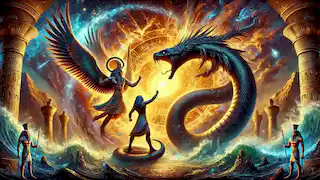
Ra’s Temptation
The Creation of Humans
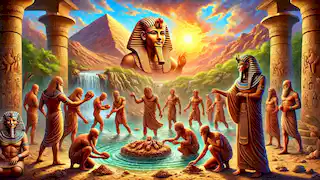
Ra’s Descent into the Duat
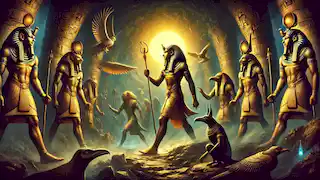
Ra’s Legacy
